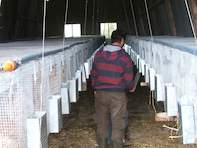Hutches must be easy to manage and clean. It is best to place them in neat rows, either in a single or double tier. Doors to the cages must be big enough to be able to take the rabbit out easily and to ensure that cleaning can easily be achieved.

In a single tier, the door can be on top or in the front of the cage, but in tired cages, the door must be in front. Door catches must be strong enough to ensure that the rabbits do not get out. When cages are placed in rows, remember to make the passage between the cages wide enough to work comfortably. You should be able to push a wheelbarrow down the row.
Manure is a very important byproduct of rabbit farming and waste. Do not discard the manure or bedding as this is valuable material will be turned into compost to fertilise your vegetable garden. Wooden floors must have bedding. This could be sawdust, straw or dry grass. Tiered wire cages must have a manure catch tray between the cages.
This could be a metal tray or heavy plastic sheeting hung under the upper hutch. The floor under the cages must be easily cleaned. If there is a sand floor, it must be swept daily while a concrete floor could have a layer of sawdust or sand that can be removed and put onto a compost heap.
No need to move rabbits when cleaning their cages as rabbits really don't mind one fiddling in their cages. Only in extreme cases of blowtorching a cage where a rabbit was sick, does one need to move the rabbit.
By Karoline Steenekamp